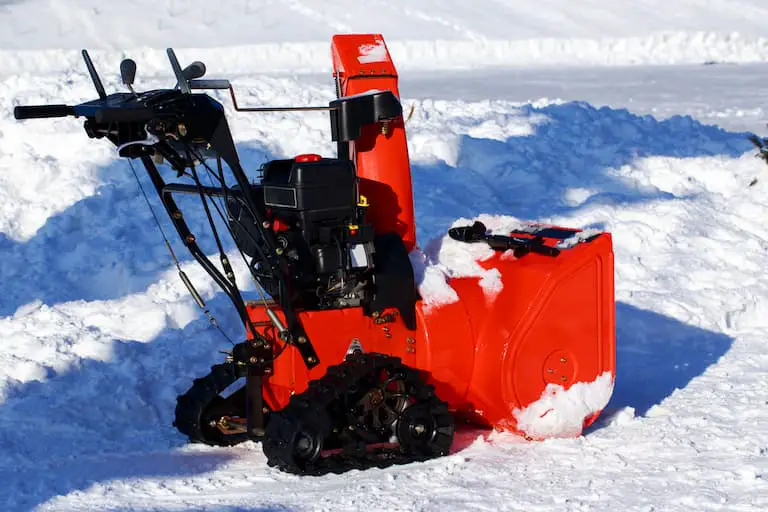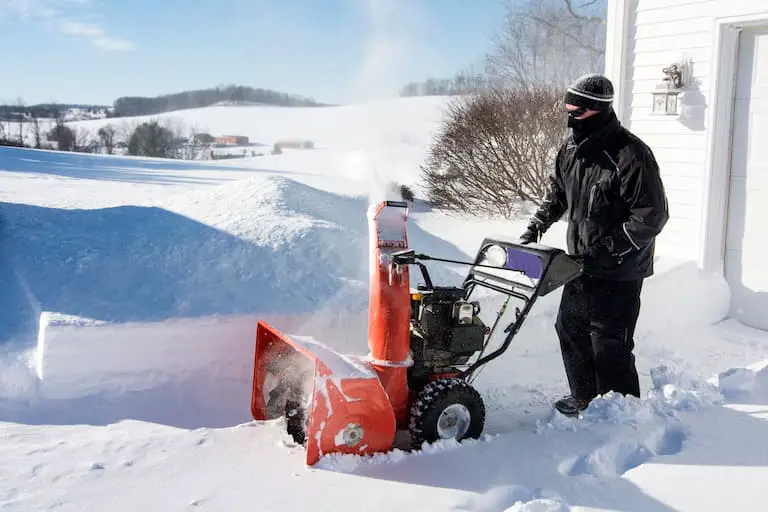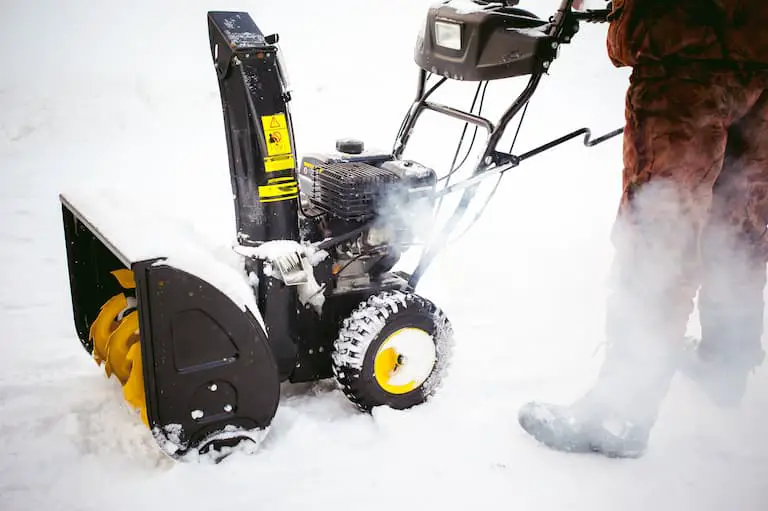As an Amazon Associate, we earn from qualifying purchases. We may also earn commissions if you purchase products from other retailers after clicking on a link from our site.
After you have talked yourself or been nudged into blowing the snow, the last thing you want is to have a flat snowblower tire. Instead of spending the money on new tires, are there some easy solutions for fixing a flat tire?
Snowblower tires go flat because the cold air reduces the PSI in a tire. You can use a bead sealer or the Rope Trick to fix your tires. Or you could spray starter fluid to set the tire’s bead. You could also fill the tire with foam or sand.
Read on to find out why tires go flat in the winter and what you can do to get air back in the tire and clear your driveway.

Cold Air Causes Snowblower Tires To Go Flat
Cold weather causes air in tires to contract, with each 10-degree reduction in temperature resulting in the loss of one PSI. In addition, if the tire’s pressure is low, the chance of a tire separating from the rim is increased.
The cold causes the air to become denser, which decreases the air pressure in the tire. In addition, the cold air weakens the rubber, causing it to become brittle.
5 Easy Solutions For Flat Snowblower Tires
As the weather turns cold, overinflating tires is the best way to prevent the tire from separating from the rim. However, even a properly inflated tire that has become brittle can go flat. Here are five ways to fix the problem.

1. Use a Bead Sealer
A bead sealer creates a flexible seal that fills in low spots on the tire’s rim. They are made specifically for this purpose, but people also use silicone.
Along with the bead sealer or silicone, you need:
- A brush or 150-grit sandpaper
- A nose plier
- A lubricant such as dishwashing liquid
- A prybar or tire lever
- A cloth
- A paintbrush or similar tool for applying the sealer
Once you’ve gathered the supplies, it’s time to get started.
- Remove the tire and deflate it with the nose pliers. Turn the metallic part inside the stem counterclockwise. Be careful so that the remaining air doesn’t shoot out the stem.
- Use a lubricant to loosen the rim and tire, and then use the pry bar to push the lip over the rim.
- Turn over the tire and repeat the process.
- Inspect and clean the rim. If you see corrosion on the rim, use sandpaper or a wire brush to remove the corrosion. Then clean off the surface of the rim, using soapy water or acetone if needed.
- Check the sidewall, and if it is dirty, clean the sidewall. Use the cloth to remove accumulated dirt.
- Use a paintbrush or similar tool to apply the bead sealer. Then mount the rim and apply sealant on the sidewall.
- Inflate the tire and wait for the sealant to dry.
2. The Rope Trick
If the leak is along the rim, use a rope to hold down the tire while inflating it. You will need a 4’ to 5’ (1.21-1.52 meters) long rope, a short piece of metal, such as a wrench handle or a long screwdriver, and an air pump.

Here’s how to perform the rope trick:
- Lift the snowblower off the ground so you can reach under the tire.
- Place the rope around the tire across the tread’s circumference and tie it off.
- Slide the wrench or screwdriver under the rope and turn it until the rope has securely fastened the tire and sealed the bead.
- Fill the tire until it reaches the recommended PSI.
- Loosen the rope, lower the snowblower, and start it up.
This trick works if the tire has become detached from the rim. If your tire is leaking at the nozzle or has cracks or holes, this won’t work. And it is not a permanent fix, but it costs nothing and can be quickly done.
Watch this video to see this fix in action.
3. Use Starter Fluid
Using starter fluid to set the tire’s bead is not for the faint of heart and probably shouldn’t be tried at home. However, it is sometimes mentioned as an option. Any flammable agent will do the trick, such as starter fluid, WD-40, or parts cleaner.
Warning: Do NOT use gasoline.
Spray a small amount of starter fluid around the rim, set it on fire, and jump back and watch the gases expand and set the bead.
Then, extinguish any remaining flames and inflate the tire to the recommended PSI.
Again, this is not a method we recommend because of the risk of serious injury. However, after you come back inside from blowing snow, or maybe to procrastinate a little, check out this Tech Insider video that explains the science behind the trick.
4. Fill Tire with Foam
If your tire has a small hole, crack, or slow leak, try filling it with foam. This hack requires a foam product like Great Stuff Insulating Foam Sealant (available on Amazon) and a valve stem remover. If you don’t have one, the Motion Pro Valve Core Remover from Amazon is a small, inexpensive tool to have handy.
Here’s the process to follow:
- Dismount the tire.
- Remove the valve stem.
- Cut additional holes into the tire to remove as much air as possible. This is an optional step, and if your tire is flat, it might not have enough air to make this step necessary.
- Attach the straw to the foam product and push it into the nozzle. Fill the tire with as much foam as possible.
- Wait until it sets. Consult the product label for the recommended time.
- Scrape off the excess foam that came from the tire.
Some people who use this method report that the foam eventually breaks down.
5. Use Sand to Fill Tire
Using sand to fill a tire is an unconventional method. You’ll need 100 lbs (45.36 kg) of silica sand, a funnel, a straw or tube that will fit over the funnel end, a drill, a mallet, a tube of silicon, and tire plugs.
Follow this process to fill your tire with sand:
- Drill a hole into the thread in the middle of the tire. It needs to be large enough for the funnel to fit in.
- Insert the funnel with the tube or straw into the hole and begin to pour sand into the funnel.
- When it stops flowing, tap on the tire with the mallet to settle the sand. Continue this process until the sand stops flowing.
- Push silicon into the hole to plug the hole, insert the tire plugs, trim off the plugs and clean up excess silicon once it dries.
The result will be a heavy tire that will be slightly lower than the other tires. A heavier tire will give you better traction, but the tilt will impact the steering.
Bottom Line
Each of these methods is less expensive than buying a set of new tires. And even though they might not be permanent fixes, if they can get you through a winter or two of snowplowing, that’s still saving over purchasing new tires that will develop the same problems.
